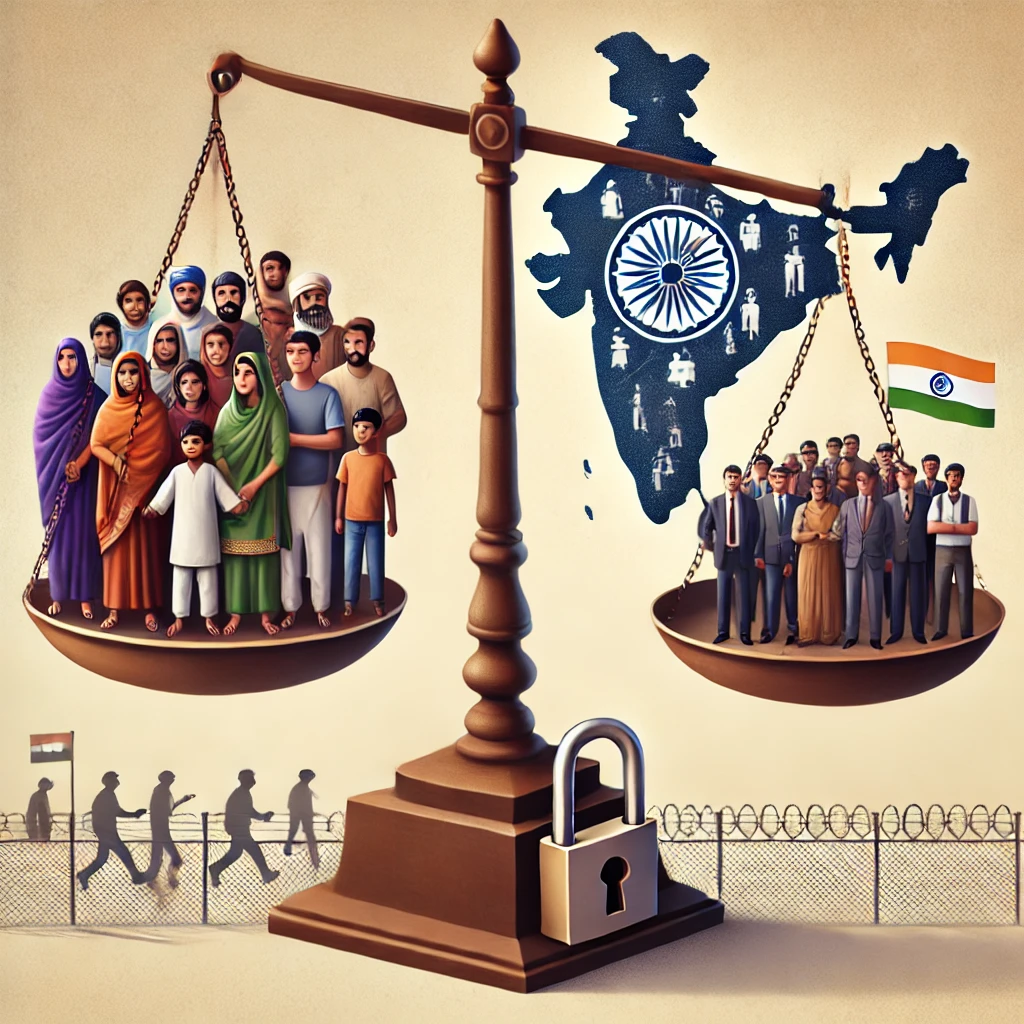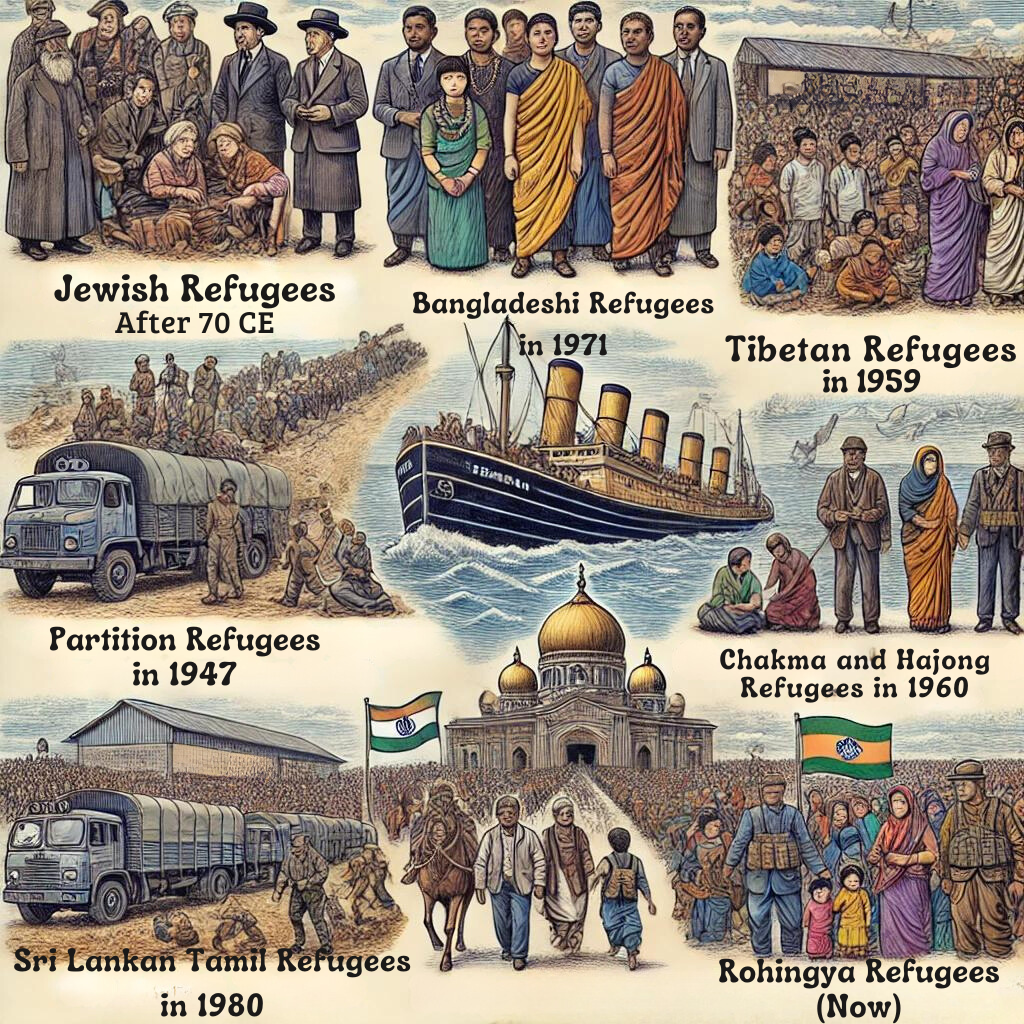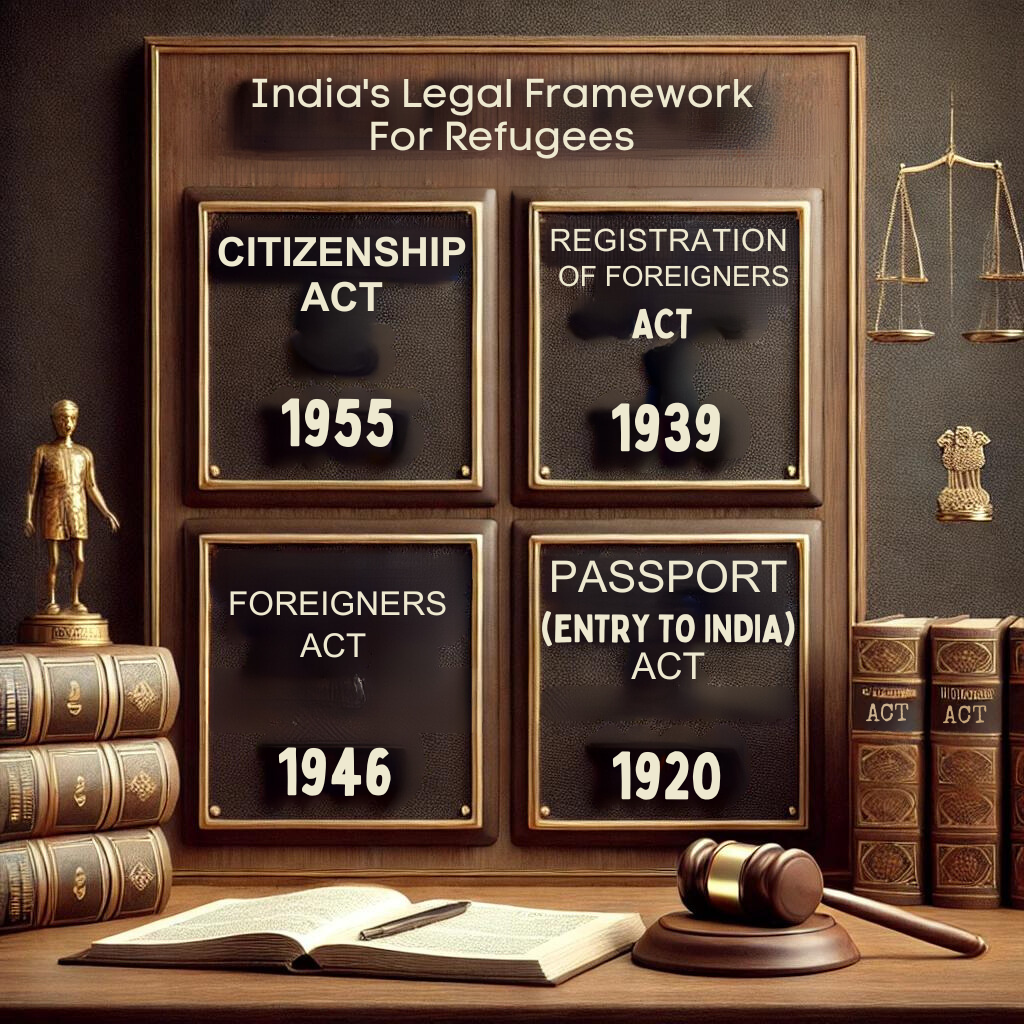World Refugee Day
World Refugee Day, observed on June 20, highlights the need for global cooperation to address the refugee crisis. With over 43.4 million refugees worldwide, India’s role is crucial, given its history of accommodating various refugee groups. Refugees are individuals fleeing severe threats to their life, safety, or freedom, often due to persecution, conflict, or violence. India’s refugee crisis is exacerbated by its non-signatory status to the 1951 Refugee Convention, political instability in neighboring countries, humanitarian considerations, natural disasters, and porous borders. India’s legal framework includes the Citizenship Act of 1955, the Foreigners Act of 1946, and the Passport (Entry into India) Act of 1920. However, these laws are not tailored specifically to refugees, highlighting the need for a more comprehensive policy.
Origin of the Article
This editorial is based on “Blueprints Beyond Borders, for Solace and Shelter” which was published in The Hindu on 20/06/2024. The article discusses the importance of international cooperation in addressing the refugee crisis and India’s role in maintaining its humanitarian image.
Importance for UPSC Aspirants
Understanding India’s refugee policy is critical for UPSC aspirants. It relates to GS Paper 2 under the UPSC syllabus, focusing on the effect of policies and politics of countries on India’s interests, international treaties, and agreements. Knowledge of this topic will help aspirants grasp the complexities of international relations and humanitarian issues.

Why in News
The refugee crisis has become a focal point due to World Refugee Day and ongoing regional conflicts. This issue is crucial for UPSC aspirants as it intersects with topics like India’s foreign policy, national security, and humanitarian obligations. Previous UPSC exams have highlighted the plight of refugees, making an understanding of India’s stance and policies essential for comprehensive preparation.
What is Considered a Refugee Crisis In India?
A refugee crisis in India involves individuals fleeing severe threats to their life, physical safety, or freedom. These threats arise from persecution, armed conflict, violence, or significant public unrest in their home countries, necessitating international protection.
About
Refugees are individuals who escape their home countries due to life-threatening conditions, such as persecution, armed conflict, violence, or significant public unrest, requiring international protection.
Causes of India’s Refugee Crisis
The absence of a legal definition, political instability, ethnic and religious persecution, natural disasters, and porous borders contribute to India’s refugee crisis.
Not A Signatory to the 1951 Refugee Convention
India is not a signatory to the 1951 Refugee Convention or its 1967 Protocol. It lacks a specific legal framework for defining refugees, making it hard to distinguish between economic migrants and asylum seekers.
Political Instability and Conflicts in Neighboring Countries
Regional conflicts and political instability, such as the partition of India, the Bangladesh liberation war, the Sri Lankan civil war, and the Rohingya crisis, have led to significant refugee influxes into India.
Ethnic, Religious Persecution and Humanitarian Considerations
Ethnic and religious persecution, such as the Chinese occupation of Tibet, has driven communities like Tibetan Buddhists to seek refuge in India.
Natural Disasters and Environmental Factors
Natural disasters, including the Nepal earthquake, floods, and cyclones, have contributed to the displacement of people seeking refuge in India.
Porous Borders and Lack of Comprehensive Refugee Policy
India’s porous borders and the absence of a comprehensive refugee policy have led to challenges in managing economic migrants and refugees, particularly from Bangladesh into northeastern states like Assam and West Bengal.
What is India’s History of Granting Asylum to Refugees?
India has a rich history of granting asylum to refugees, shaped by humanitarian considerations and diplomatic relations with neighboring countries, welcoming various significant refugee groups over the years.

Jews Refugees
India has a long history of providing refuge to Jews, especially after the destruction of Herod’s Temple in 70 CE during the First Jewish-Roman War, leading to their dispersion.
Tibetan Refugees
In 1959, India granted asylum to Tibetan refugees fleeing the Chinese occupation of Tibet, establishing settlements for their rehabilitation.
Partition Refugees
The partition of India in 1947 led to one of the largest refugee crises, with millions of refugees from the newly formed state of Pakistan being accommodated.
Chakma and Hajong Refugees
In the early 1960s, India accepted the Chakma and Hajong communities displaced from the Chittagong Hill Tracts region of present-day Bangladesh.
Refugees from East Pakistan (now Bangladesh)
During the Bangladesh Liberation War in 1971, India hosted a significant number of Bangladeshi refugees, providing them with shelter and aid.
Sri Lankan Tamil Refugees
Since the 1980s, India has served as a refuge for Sri Lankan Tamils escaping the civil war and ethnic violence in Sri Lanka.
Rohingya Refugees
India has recently faced the challenge of accommodating Rohingya refugees, a persecuted Muslim minority fleeing violence in Myanmar’s Rakhine State.
Why has India not Signed the 1951 Refugee Convention?
India has not signed the 1951 Refugee Convention due to concerns over the definition of refugees, perceived Eurocentrism, sovereignty, national security, resource limitations, and potential misuse of provisions.
Definition of Refugee is Discriminatory
India finds the 1951 Convention’s definition of refugees too narrow, excluding those fleeing economic deprivation or lack of livelihood opportunities, which could place a significant burden on developed nations.
Eurocentrism
India views the 1951 Refugee Convention as Eurocentric, focusing on European issues at the time of its drafting and not addressing the specific challenges faced by South Asian countries.
Sovereignty and National Security Concerns
India fears that signing the convention may compromise its sovereignty and ability to regulate the entry and stay of foreign nationals, impacting national security and border control policies.
Lack of Resources and Infrastructure
India cites limited resources and inadequate infrastructure as reasons for not signing the convention, as it may struggle to provide the required assistance and protection to a large influx of refugees.
Concerns Over Potential Misuse
There are apprehensions that the convention’s provisions could be misused by economic migrants or individuals with ulterior motives, posing potential security risks, such as links to extremist organizations.
What is the Legal Framework Related to Refugees In India?
India’s legal framework concerning refugees includes various acts such as the Citizenship Act, 1955, the Registration of Foreigners Act, 1939, the Foreigners Act, 1946, and the Passport (Entry into India) Act, 1920.

Citizenship Act, 1955
The Citizenship Act, 1955, and the Citizenship Amendment Act, 2019, provide provisions for renunciation, termination, and deprivation of citizenship, offering a pathway to citizenship for persecuted minorities but excluding Muslims.
Registration of Foreigners Act of 1939
This act mandates that foreign nationals visiting India on a long-term visa must register with a registration officer within 14 days of arrival.
Foreigners Act of 1946
The Foreigners Act of 1946 empowers the Central government to detect, detain, and deport illegal foreign nationals present in the country.
Passport (Entry into India) Act, 1920
Section 5 of this act allows authorities to forcibly remove illegal foreigners from India, under Article 258(1) of the Constitution, which requires the president’s and governor’s consent.
PESTEL Analysis
| Political: India’s refugee policy is heavily influenced by political considerations, particularly national security and sovereignty concerns. The lack of formal alignment with international standards like the 1951 Refugee Convention reflects a prioritization of political and security issues over a standardized humanitarian approach. Economic: The economic impact of refugees in India is a crucial factor, especially given the country’s citation of limited resources as a reason for not signing the Refugee Convention. Economic migrants often blend with genuine refugees, complicating policy enforcement and resource allocation. Social: India has a strong tradition of providing asylum based on social and humanitarian grounds, such as religious or ethnic persecution. This societal willingness to help is tempered by challenges in integrating diverse refugee populations and managing social tensions. Technological: While not directly mentioned, technological advancements could improve India’s refugee management through better border controls and data management systems, enhancing the differentiation between economic migrants and refugees. Environmental: Environmental factors like natural disasters in neighboring regions often push people to seek refuge in India. This adds a layer of complexity to refugee management, as these are not conflict-driven but are equally urgent. Legal: India’s legal framework for refugees is piecemeal and not specifically tailored to the unique needs of refugees. Laws like the Citizenship Act and the Foreigners Act focus more on general foreign nationals than on the specificities of refugees, which might create gaps in protection and management. |
What Should be the Future Strategy to Tackle the Refugee Crisis In India?
Future strategies to address the refugee crisis in India should focus on upholding international principles, enhancing diplomatic engagement, balancing security and humanitarian concerns, and protecting vulnerable groups.
Upholding Non-refoulement
India should uphold the non-refoulement principle, prohibiting the return of asylum seekers to countries where they face persecution and torture, in line with international refugee law.
Enhanced Diplomatic Engagement and International Cooperation
India should enhance diplomatic efforts and international cooperation, such as expanding cooperation with the UNHCR and initiatives like Operation Insaniyat for Rohingya aid.
Balancing Security and Humanitarian Concerns
India needs to balance security interests with humanitarian obligations by implementing temporary identification systems for refugees while ensuring essential services.
Women and Child Protection
Specific programs aimed at protecting vulnerable groups, such as the UNHCR’s “Safe from the Start” program, should be implemented to prevent sexual and gender-based violence in refugee camps.
Long-term Regional Strategy
India should work towards a long-term regional strategy, similar to the Comprehensive Plan of Action for Indochinese Refugees, involving multiple Southeast Asian countries for a permanent solution.
Balancing its traditions of hospitality with evolving geopolitical realities remains a critical task for policymakers and society at large. Addressing the refugee situation in India requires a nuanced approach that integrates humanitarian concerns, national security, and regional cooperation.
Conclusion
In conclusion, India’s approach to managing the refugee crisis is at a crucial juncture. Balancing humanitarian principles with national security and fostering international cooperation is key. Civil services aspirants must understand the complexities of these issues, as they play a pivotal role in shaping policies that uphold human dignity while safeguarding national interests. This evolving landscape demands thoughtful and informed leadership.
| UPSC Civil Services Examination, Previous Year Questions (PYQs) Mains Q. Discuss the issues of refugees in India, focusing on their major challenges and possible measures to improve their condition. (GS-II, 2022) Q. Examine the role of international conventions and protocols, such as the 1951 Refugee Convention and the 1967 Protocol, in shaping India’s approach to refugee protection. Discuss how India’s stance aligns with or diverges from these international standards. |


